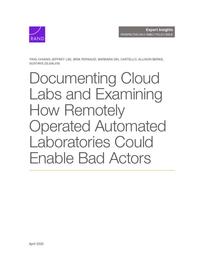Documenting Cloud Labs and Examining How Remotely Operated Automated Laboratories Could Enable Bad Actors
Expert InsightsPublished Apr 24, 2025
Expert InsightsPublished Apr 24, 2025

Research laboratories that allow for remote execution of experiments and rely heavily on automation, known as cloud labs, can be manifestations of the convergence of artificial intelligence and biotechnology. However, the automation and remote capabilities that define cloud labs also could introduce specific risks, particularly in the context of biosecurity. The potential for misuse by malicious actors to develop harmful chemical or biological weapons through these platforms is a notable concern.
In this paper, the authors provide an overview of 15 cloud lab organizations around the world, including details on the facility size, the number of scientific instruments, location, and the type of science they focus on. The authors then discuss how cloud labs could enable bad actors in developing and proliferating chemical or biological weapons. This discussion may be of interest to cloud lab organizations and stakeholders in science automation who have responsibilities to inform policymakers about the current state of cloud lab organizations and potential vulnerabilities of the cloud lab model to facilitate the safe and secure development of scientific cloud labs.
This work was conducted by the Technology and Security Policy Center within RAND Global and Emerging Risks.
This publication is part of the RAND expert insights series. The expert insights series presents perspectives on timely policy issues.
This document and trademark(s) contained herein are protected by law. This representation of RAND intellectual property is provided for noncommercial use only. Unauthorized posting of this publication online is prohibited; linking directly to this product page is encouraged. Permission is required from RAND to reproduce, or reuse in another form, any of its research documents for commercial purposes. For information on reprint and reuse permissions, please visit www.rand.org/pubs/permissions.
RAND is a nonprofit institution that helps improve policy and decisionmaking through research and analysis. RAND's publications do not necessarily reflect the opinions of its research clients and sponsors.